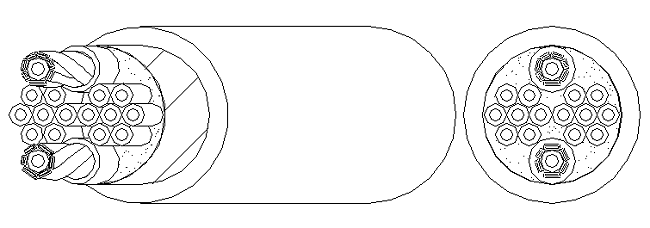Introduction
Over the past five years, corresponding with the
increased interest in A/V cables, a number of cable companies have appeared
throughout the world to supply us with great products.
Note that if you go back just a decade or so,
there really was no big interest in high performance cables, at least for the masses.
Now of course, going into just about any hi-fi
store, be it a high end salon, or mass market stores like Circuit City and
Best Buy, you will be presented with nice displays of all kinds of cables.
For a long time, Monster Cable® dominated the
displays in the chain stores. They really got in on the ground floor with
mass market cables way back when, and they have a huge line of products,
which now include such things as power amplifiers and AC line conditioners.
There are other brands in the chain stores now
besides Monster, and that's good, because it keeps the prices affordable.
As to the high end salons, you find products
that most of us would love to have, but they are not what you would call
"affordable." However, that word is relative. To a high performance audio/video
aficionado, it's all affordable, because we end up buying that pricey stuff.
Be it a Lamm L2 Reference Preamplifier, a pair
of McIntosh MC1201 Power Amplifiers, some B&W 800D speakers, or . . .
well, whatever it is, we are willing to spend the money to have the
best.
So, to us, it's affordable. Sometimes, just
barely, but we buy it anyway. We have to. It's in our nature. Hi-fi is our
"thing."
Spending a lot of money on cables is something
that many consumers have great contempt for. There are several reasons for
this. One is that it has been very difficult to show, conclusively, that
high end cables really make a difference. We who are fans of high end cables
believe that they do. We are pretty sure we can hear the difference, but the
problem is that whatever difference there is, is only just a little bit of
improvement, let's say 5%. It's that last tiny amount that we are trying to squeeze out of
the sound system.
But, that's the same with all high performance
products. The fabulous power amplifier costs ten times as much as the
amplifiers in a mass market receiver, but it is reaching for that last 20%
of the sound quality that requires such manufacturing. Are audio-crazed
consumers willing to pay for that? You bet!
If any great cable produced that small
improvement
with any system, the arguments probably would have ended a long time ago,
because it would have been easier to prove that it is occurring.
Unfortunately, whether a particular cable improves the sound in a particular
system, depends on the various components in that system, e.g., input and
output impedances. And, a big problem is that we don't really know which
component factors are necessary for a cable with certain electrical
properties to work best with those components. So, sometimes, a great cable
might not improve a particular system if the other factors are not in
alignment.
Secondly, and perhaps most importantly, high
end cables are basically just wires aren't they? So, why are they so
expensive?
The answer is that a lot of expense (labor)
goes into the testing and perfection of the various designs. And whether it
is design time for an output stage of a preamplifier, or a cable, the labor
is the same cost. Engineers have to calculate the mathematics, build
prototypes, measure values on oscilloscopes, and listen to the results.
So, the end product is expensive, just as if
it had a bunch of transistors, capacitors, and inductors.
Legenburg
I had not heard of this company until a year
ago when I attended an audio convention in Los Angeles.
Their speaker cables - in this case,
the Zeus - were sitting in a beautiful box on a chair outside one of the
exhibit rooms.
I photographed them because they were so
exquisite to look at. Little did I know that quite a while later, I would be
listening to some Legenburg cables in my reference system.
For this review, Legenburg sent their Artemis,
which included RCA interconnects, XLR interconnects, and speaker cables.
Yes, they are very expensive. $3,750 would be
considered a reasonable chunk of money for a CD player, preamp, power amp, a
pair of speakers, and for a set of speaker cables too.
Again, remember that a lot of engineering has
gone into all those products, including the cables.
To start off, the build quality on the
Legenburgs is just spectacular.
Of course, one can't see the insides of cables
like you can do with a preamplifier by taking off the chassis cover, so here
is a diagram of the speaker cable cross section.

You can see that the conductor
configuration is complex. The hexagonal shapes are micro-porous Teflon air tubes, and inside the
tubes are rectangular conductors (like small thin blades).
You might say, "Well, winding a
cable this way shouldn't be really expensive."
Of course it's not expensive. At
least, it doesn't cost a couple of thousand dollars to make them, although
with those blade-like conductors sitting inside air tubes with Teflon
dielectric, I imagine it costs more than one might imagine.
But, it's that engineering design
cost that comes in here. Getting to this conductor configuration was where
the costs were. Think of the endless ways the conductors can be arranged
next to one another. The size, the spacing, the amount of dielectric, the
arrangement of the shielding, etc.
And, the problem is that such products are always manufactured in small
numbers, so the engineering costs have to be spread out over those smaller
numbers that end up being made.
Click Here to Go to Part II.